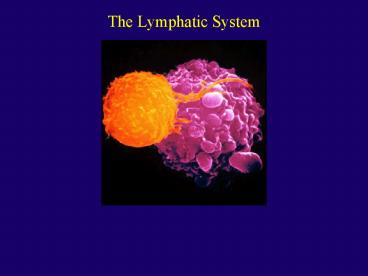The Lymphatic System PowerPoint PPT Presentation
1 / 22
Title: The Lymphatic System
1
The Lymphatic System
2
The Lymphatic System
- Functions Of The Lymphatic System
- Transport Excess Interstitial Fluid Back To
Bloodstream - Transport Dietary Lipids
- House Lymphocytes
- Generate An Immune Response
3
Orders Of Lymphatic Vessels
- Lymph capillaries - smallest lymph vessels, first
to receive lymph - Lymphatic collecting vessels - collect from lymph
capillaries - Lymph nodes - scattered along collecting vessels
- Lymph trunks - collect lymph from collecting
vessels - Lymph ducts - empty into veins of the neck
4
Lymphatic Capillaries
- Located near blood capillaries
- Receive tissue fluid from CT
- Minivalve flaps open and allow fluid to enter
- Highly permeability allows entrance of tissue
fluid, bacteria, viruses, and cancer cells - Lacteals specialized lymphatic capillaries
- Located in the villi of the small intestines
- Receive digested fats, Fatty lymph chyle
5
Lymphatic Collecting Vessels
- Accompany blood vessels
- Composed of the same three tunics as blood
vessels - Contain more valves than veins do
- helps direct the flow of blood
- Lymph propelled by
- contraction of skeletal muscles
- pulse pressure of nearby arteries
- Tunica media of the lymph vessels
6
Lymph Nodes
- Cleanse the lymph of pathogens
- Human body contains around 500
- Lymph nodes are organized in clusters
7
Microscopic Anatomy of a Lymph Node
- Fibrous capsule surrounds lymph nodes
- Trabeculae connective tissue strands
- Lymph vessels
- Afferent lymphatic vessels
- Efferent lymphatic vessels
8
Lymph Trunks
- Lymphatic collecting vessels converge
- Five major lymph trunks
- Lumbar trunks
- Receives lymph from lower limbs
- Intestinal trunk
- Receives chyle from digestive organs
- Bronchomediastinal trunks
- Collects lymph from thoracic viscera
- Subclavian trunks
- Receive lymph from upper limbs and thoracic wall
- Jugular trunks
- Drain lymph from the head and neck
9
Lymph Ducts
- Cisterna chyli - located at the union of lumbar
and intestinal trunks - Thoracic duct - ascends along vertebral bodies
- Empties into venous circulation
- Junction of left internal jugular and left
subclavian veins - Drains three quarters of the body
- Right lymphatic duct - empties into right
internal jugular and subclavian veins
10
The Immune System
- Recognizes specific foreign molecules
- Destroys pathogens effectively
- Key cells lymphocytes
- Also includes lymphoid tissue and lymphoid organs
11
Lymphocytes
- Infectious organisms attacked by inflammatory
response, macrophages, then lymphocytes - T Lymphocytes
- Helper T-lymphocytes have receptors (CD4) that
can recognize an antigen - Secrete cytokines (chemical signals that bind to
receptors on other lymphatic cells and activate
them) and - Present the antigen to a B-lymphocyte.
- Cytotoxic T lymphocytes attack foreign cells
directly - Receptors (CD8) bind to antigen-bearing cells
- Perforates cell membrane
- Signals cell to undergo apoptosis (self
destruction) - B lymphocytes
- Become plasma cells
- Secrete antibodies bind and mark cells for
destruction by macrophages
12
Lymphocyte Function
Figure 20.7
13
Lymphocyte Activation
- Lymphocytes originate in bone marrow
- Some travel to the thymus gland - T lymphocytes
- Some stay in bone marrow - B lymphocytes
- Able to recognize a unique antigen
- Gain immunocompetence
- Travels through blood stream
- Meets and binds to a specific antigen
14
Lymphocyte Activation
- Activating T or B cells produce
- Effector lymphocytes - short-lived, attack
immediately - Memory lymphocytes - wait until body encounters
their antigen again - Basis of acquired immunity
- Guard against subsequent infections
15
Lymphocyte Activation
Figure 20.8
16
Lymphoid Tissue
- Lymphoid tissue - areolar connective tissue and
lymphocytes - Most important tissue of the immune system
- Mucous membranes of digestive, urinary,
respiratory, and reproductive tracts - Mucosa-associated lymphoid tissue (MALT)
- Makes up lymphoid organs (except thymus)
17
Lymphoid Organs
- Primary lymphoid organs
- Bone marrow
- Thymus
- Secondary lymphoid organs
- Designed to gather and destroy infectious
microorganisms - Lymph nodes, spleen, tonsils
- Aggregated lymphoid nodules - masses of lymphoid
tissue NOT surrounded by a fibrous capsule. - Appendix
18
Thymus
- Immature lymphocytes develop into T lymphocytes
- Secretes thymic hormones
- Most active in childhood
- Functional tissue atrophies with age
- Composed of cortex and medulla
- Medulla contains Hassalls corpuscles (thymic
corpuscles) - Differs from other lymphoid organs
- Functions strictly in lymphocyte maturation
- Arises from epithelial tissue
19
Lymphoid Organs
- Lymph nodes
- Lymph percolates through lymph sinuses
- Most antigenic challenges occur in lymph nodes
- Antigens destroyed and activate B and T
lymphocytes - Spleen
- Largest lymphoid organ
- Two main blood-cleansing functions
- Removal of blood-borne antigens
- Removal and destruction of old or defective blood
cells - Site of hematopoiesis in the fetus
20
Spleen
- Destruction of antigens
- Site of B cell maturation into plasma cells
- Phagocytosis of bacteria and worn-out blood cells
- Storage of platelets
- White pulp
- Thick sleeves of lymphoid tissue
- Provides the immune function of the spleen
- Red pulp - surrounds white pulp, composed of
- Venous sinuses filled with whole blood
- Splenic cords reticular CT rich in macrophages
21
Tonsils
- Simplest lymphoid organs
- Four groups of tonsils
- Palatine, lingual, pharyngeal and tubal tonsils
- Arranged in a ring to gather and remove pathogens
- Underlying lamina propria consists of MALT
22
Aggregated Lymphoid Nodules And Appendix
- MALT abundant in walls of intestines
- Fight invading bacteria
- Generate a wide variety of memory lymphocytes
- Aggregated lymphoid nodules (Peyers patches)
- Located in the distal part of the small intestine
- Appendix tubular offshoot of the cecum

